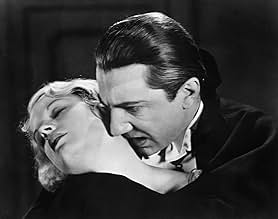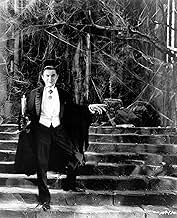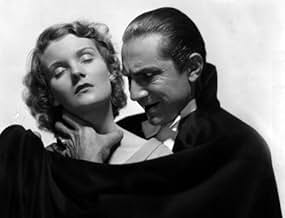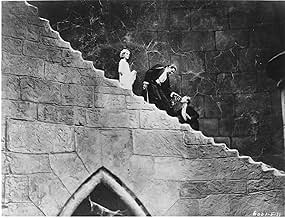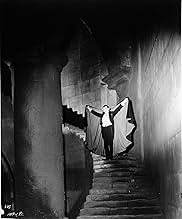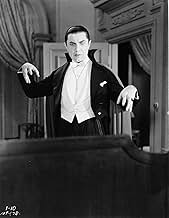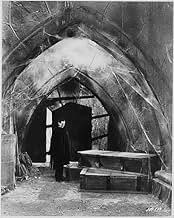IMDb-BEWERTUNG
7,3/10
62.629
IHRE BEWERTUNG
Der alte Vampir Graf Dracula kommt in England an und stellt dort der tugendhaften jungen Mina nach.Der alte Vampir Graf Dracula kommt in England an und stellt dort der tugendhaften jungen Mina nach.Der alte Vampir Graf Dracula kommt in England an und stellt dort der tugendhaften jungen Mina nach.
- Auszeichnungen
- 5 Gewinne & 3 Nominierungen insgesamt
Charles K. Gerrard
- Martin
- (as Charles Gerrard)
Anna Bakacs
- Innkeeper's Daughter
- (Nicht genannt)
Bunny Beatty
- Flower Girl
- (Nicht genannt)
Nicholas Bela
- Coach Passenger
- (Nicht genannt)
Daisy Belmore
- Coach Passenger
- (Nicht genannt)
William A. Boardway
- Concertgoer Outside Theatre
- (Nicht genannt)
Barbara Bozoky
- Innkeeper's Wife
- (Nicht genannt)
Tod Browning
- Harbormaster
- (Synchronisation)
- (Nicht genannt)
Moon Carroll
- Maid
- (Nicht genannt)
Geraldine Dvorak
- Dracula's Wife
- (Nicht genannt)
Empfohlene Bewertungen
This is the movie that set the horror genre into action. Sure there may be a few campy scenes that look like they might be out of some high school play production (the rubber bats and armadillos in Dracula's castle come to mind), but there is an unmistakable suspense and eerieness about the film. If you are lucky enough to find the DVD reissue from 1999, you have three great versions: the original 1931 version with basically no background music, the 1999 rescoring of the movie by composer Philip Glass, and the extremely interesting Spanish version, made at the same time as the original (with totally different actors). If you have this DVD, watch the movie twice: once with no soundtrack and once with the Glass rescoring.... totally different movie. Glass' score is great, but it doesn't really help the movie at all (it actually hurts it in many cases). But the utter silence in Browning's original just makes my skin crawl! The acting is actually quite great (Lugosi is, of course, phenomenal as is Dwight Frye as Renfield). The fear, the suspense, and, believe it or not, the sexuality, combines for a great movie that was an unbelievable success in its first release ($700,000 in it first US release, $1.2 million worldwide). Not bad for a movie made 72 years ago!
Bela Lugosi forever captures the role of a certain undead Transylvanian count who takes a trip to London in the first legitimate version of the classic Bram Stoker novel. Despite many attempts by many talented film makers, I believe this version, directed by Tod Browning, remains the definitive take on the often-filmed novel. But why? Is it simply nostalgia? Granted, I do fondly remember staying up late as a child watching this film on Ghost Host theater and finding myself suitably frightened. However, if I were the same age today, would I find the film as effective? Would a steady diet of more modern and explicit horror films made me too jaded to enjoy the more subtle charms of this film? I hope not, but I could see how it might. The film is slow, and its slowness is further emphasized by the absence of an under score. It is stagey - being as it was more influenced by the stage play than the novel itself. Also, the story plays itself out too quickly. Van Helsing manages to figure everything out and dispatch the count in about two seconds. There simply isn't much suspense - and even less gore or violence. Yet it remains the champ. Why? The main reason is Lugosi himself. He gives the performance of a lifetime. He truly inhabits the role and is genuinely creepy. The rest of the cast, particularly Edward Van Sloan as Van Helsing and Dwight Frye as Renfield, support him admirably. However, when I watch the old Universal horror films nowadays, I find myself really enjoying the atmospheric sets and lighting. Yes, there is still much to love about Dracula today. (As long as you avoid the optional Philip Glass score on the DVD!)
The 1931 `Dracula' casts an imposing shadow over the horror genre. It is, after all, the movie that launched the classic Universal horror cycle of the 1930s and 1940s. It is also a tremendous influence on the look and atmosphere of horror movies in general (and vampire movies in particular). It gave Dracula a look and a voice, and created a legend.
Okay, so we know it was influential. But how does it work as a movie? Well the first time I watched it, I was underwhelmed. The pace is slow. While Bela Lugosi's Dracula is menacing, the rest of the cast is colorless to the point of transparency. There are some good gliding camera shots here and there (thank you, Karl Freund!), but the majority of the film is locked into stationary medium and long shots. The film is tightly bound to its theatrical origins director Browning has his characters look at things out of frame and describe them rather than just showing us, which would be much more effective.
Fortunately, `Dracula' improves with repeated viewings. The glacial pace and lack of sound in many places gives the movie a nightmarish sense of menace. In fact, `Dracula' is somewhere between a nightmare and a piece of classical music everything proceeds at its own pace, gliding through the motions, gradually building suspense and momentum until the piece reaches climax. The end result is a flawed but haunting, hypnotic masterpiece, and one of the greatest vampire films ever made.
Okay, so we know it was influential. But how does it work as a movie? Well the first time I watched it, I was underwhelmed. The pace is slow. While Bela Lugosi's Dracula is menacing, the rest of the cast is colorless to the point of transparency. There are some good gliding camera shots here and there (thank you, Karl Freund!), but the majority of the film is locked into stationary medium and long shots. The film is tightly bound to its theatrical origins director Browning has his characters look at things out of frame and describe them rather than just showing us, which would be much more effective.
Fortunately, `Dracula' improves with repeated viewings. The glacial pace and lack of sound in many places gives the movie a nightmarish sense of menace. In fact, `Dracula' is somewhere between a nightmare and a piece of classical music everything proceeds at its own pace, gliding through the motions, gradually building suspense and momentum until the piece reaches climax. The end result is a flawed but haunting, hypnotic masterpiece, and one of the greatest vampire films ever made.
... and that explains all of the differences, such as Renfield being the person to visit Dracula in Transylvania to seal a real estate deal rather than Jonathan Harker.
I imagine this was quite the spectacle in 1931. Visually it still is - sweeping staircases, ruined old castles covered in dust, moonlight illuminating giant spiderwebs, coffins with limbs hanging out of them, rats scurrying about. And Bela Lugosi, who starred in the Broadway play, was dying to play the lead. But director Tod Browning was set on Lon Chaney, a frequent collaborator, playing both Dracula and Van Helsiing.
It's not true that everybody is replaceable, but it IS true that eventually an irreplaceable person will no longer be around and a perhaps less than ideal work-around must be found. This was the situation with Chaney - a unique actor who could convince you he was anybody. He died before Dracula was filmed. Lugosi successfully lobbied for the part, although he did so at a cut rate. Today his old world hypnotic presence is synonymous with the role.
But I have to admit I have an unpopular opinion. To me Dracula seems very slow and very much "early talkie" in personality when compared to the film Frankenstein of just a year later. Also, like many early talking films that were not musicals, there is no score.
And I have to wonder about director Tod Browning. Although this was Browning's biggest hit, his other enduring works all starred Lon Chaney. He only directed a few more films and disappeared from the industry for a quarter of a century until his death. He had a disappearing act worthy of Universal Horror.
Things to watch for - Armadillos in Transylvania? Probably far too cold for them there. David Manners and Helen Chandler as young lovers Jonathan Harker and Mina - They have all of the chemistry of two cardboard boxes. Why did they keep pairing these two in films? Dwight Frye as Renfield - did Frye EVER get to play a normal person? And why would he want to be sent away? He gets to wander in and out of the lush living quarters of the superintendent f the mental facility. He wouldn't get that freedom anywhere else. And last but not least, Carla Laemmle, unrecognizable as a tourist, reading from a Transylvania tour guide.
I imagine this was quite the spectacle in 1931. Visually it still is - sweeping staircases, ruined old castles covered in dust, moonlight illuminating giant spiderwebs, coffins with limbs hanging out of them, rats scurrying about. And Bela Lugosi, who starred in the Broadway play, was dying to play the lead. But director Tod Browning was set on Lon Chaney, a frequent collaborator, playing both Dracula and Van Helsiing.
It's not true that everybody is replaceable, but it IS true that eventually an irreplaceable person will no longer be around and a perhaps less than ideal work-around must be found. This was the situation with Chaney - a unique actor who could convince you he was anybody. He died before Dracula was filmed. Lugosi successfully lobbied for the part, although he did so at a cut rate. Today his old world hypnotic presence is synonymous with the role.
But I have to admit I have an unpopular opinion. To me Dracula seems very slow and very much "early talkie" in personality when compared to the film Frankenstein of just a year later. Also, like many early talking films that were not musicals, there is no score.
And I have to wonder about director Tod Browning. Although this was Browning's biggest hit, his other enduring works all starred Lon Chaney. He only directed a few more films and disappeared from the industry for a quarter of a century until his death. He had a disappearing act worthy of Universal Horror.
Things to watch for - Armadillos in Transylvania? Probably far too cold for them there. David Manners and Helen Chandler as young lovers Jonathan Harker and Mina - They have all of the chemistry of two cardboard boxes. Why did they keep pairing these two in films? Dwight Frye as Renfield - did Frye EVER get to play a normal person? And why would he want to be sent away? He gets to wander in and out of the lush living quarters of the superintendent f the mental facility. He wouldn't get that freedom anywhere else. And last but not least, Carla Laemmle, unrecognizable as a tourist, reading from a Transylvania tour guide.
"I bid you welcome," "I never drink wine," "Children of the night...what music they make," and of course "I am Dracula" are memorable lines that resonate throughout horror films, literature, art, etc... throughout the 20th century because of a landmark film made in 1931 starring Bela Lugosi and directed by Tom Browning. This film was the birth of the horror film as we know it. Its importance can not be underestimated. Dracula is a wonderful film for so many reasons, but first let's look at its many faults.
The film is by today standards very antiquated. It has almost no soundtrack, stage acting for the most part, limited special effects, and a slow pacing. It has long parts of little action and lots of chat. It shows little while leaving much to one's imagination(a plus for those like myself that are good at envisioning what is not shown). With all this not going for it, why is Dracula such a classic? Why is it considered to be such a great film and a great horror film?
The answer is that even with all these flaws (and bear in mind some of these flaws are not flaws for all) the film offers a rich story in an eerie, atmospheric way. Bela Lugosi was Dracula. He was the model for oh so many vampires to come. His gesturing, his deliberation in speech, his facial movements all created a vampire never to be forgotten. Despite Lugosi, however, is the real genius of the film....Tod Browning. Browning created a movie and a setting hitherto imagined and conjured on a screen. Browning was the man behind the camera that created the cob-webbed stairs of the Dracula castle and the squalid emptiness of the crypt. He created the ghoulish female vampires thirsting for blood. Dracula is not just a film to see, it is film history and should be viewed with that in mind and not put under a microscope of today's languishing tastes.
The film is by today standards very antiquated. It has almost no soundtrack, stage acting for the most part, limited special effects, and a slow pacing. It has long parts of little action and lots of chat. It shows little while leaving much to one's imagination(a plus for those like myself that are good at envisioning what is not shown). With all this not going for it, why is Dracula such a classic? Why is it considered to be such a great film and a great horror film?
The answer is that even with all these flaws (and bear in mind some of these flaws are not flaws for all) the film offers a rich story in an eerie, atmospheric way. Bela Lugosi was Dracula. He was the model for oh so many vampires to come. His gesturing, his deliberation in speech, his facial movements all created a vampire never to be forgotten. Despite Lugosi, however, is the real genius of the film....Tod Browning. Browning created a movie and a setting hitherto imagined and conjured on a screen. Browning was the man behind the camera that created the cob-webbed stairs of the Dracula castle and the squalid emptiness of the crypt. He created the ghoulish female vampires thirsting for blood. Dracula is not just a film to see, it is film history and should be viewed with that in mind and not put under a microscope of today's languishing tastes.
Wusstest du schon
- WissenswertesGenerally regarded as the film that kickstarted the horror genre in Hollywood.
- PatzerIn the scene where Van Helsing is attempting to catch Dracula's lack of reflection in a mirror, there are visible chalk marks on the floor showing Bela Lugosi where to stand for the shot.
- Zitate
Count Dracula: This is very old wine. I hope you will like it.
Renfield: Aren't you drinking?
Count Dracula: I never drink... wine.
- Crazy CreditsThe original title card has producer Carl Laemmle, Jr. identified as Presient (sic).
- Alternative VersionenA version of the film played on the 10/24/15 airing of Svengoolie (1995) featured a soundtrack taken from the French language audio track on the Dracula Blu-ray.
- VerbindungenAlternate-language version of Dracula (1931)
- SoundtracksSwan Lake, Op.20
(1877) (uncredited)
Music by Pyotr Ilyich Tchaikovsky
Excerpt Played during the opening credits
Top-Auswahl
Melde dich zum Bewerten an und greife auf die Watchlist für personalisierte Empfehlungen zu.
Details
- Erscheinungsdatum
- Herkunftsland
- Offizieller Standort
- Sprachen
- Auch bekannt als
- Drácula
- Drehorte
- Produktionsfirma
- Weitere beteiligte Unternehmen bei IMDbPro anzeigen
Box Office
- Budget
- 355.000 $ (geschätzt)
- Weltweiter Bruttoertrag
- 87.019 $
- Laufzeit
- 1 Std. 15 Min.(75 min)
- Seitenverhältnis
- 1.20 : 1(original release)
Zu dieser Seite beitragen
Bearbeitung vorschlagen oder fehlenden Inhalt hinzufügen


